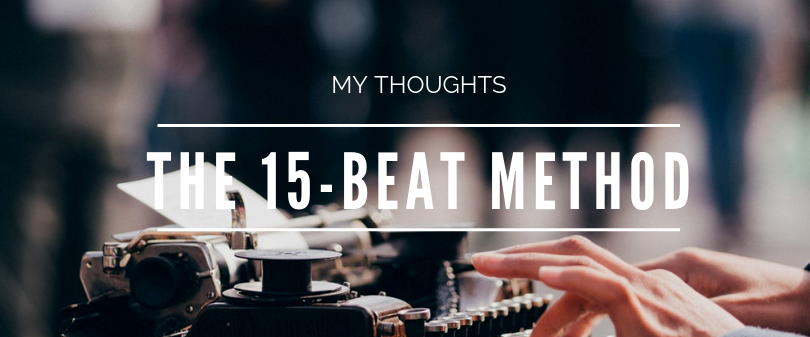
Hey everyone!
I’ve been talking about the 15-Beat method for outlining a novel for a while, and it seemed like some of you were curious about it… so here we go! A few points that I want to hit before we start:
- The 15-Beat Method, also known as “Blake Snyder’s Beat Sheet” is a fairly well-known method for outlining a book. I did not invent it so I can’t take credit! In this post I want to share with you guys my experience with it, what I liked and what I disliked.
- This is not an instructional post about how to use this method. There are many great blog articles, books, and youtube videos which I will link here, as they will probably do a better job explaining the method than I do haha :’)
- This method was initially published in a book titled “Save the Cat” by Blake Snyder, which is originally intended to guide screenplay writers, although the method has been adapted for writers (“Save the Cat! Writes a Novel” by Jessica Brody.) My experience is based solely on what I’ve learned about this method through the free online resources since I haven’t had a chance to read these works. (So take my words with a grain of salt hahahah…)

What is it?
The idea of Blake Snyder’s 15-Beat Method is that every screenplay (or in this case, novel) can be boiled down into 15 beats. These beats include the “Opening Image“, which sets the tone of the novel and presents a snapshot of the main character’s problem. The opening image is followed by the “Set-up“, “Theme Stated“, “The Catalyst“, “Debate“, etc. For a more comprehensive description of each of the beats and what they entail, check out these resources:
- Tim Stout’s article about Blake Snyder’s beat sheet
- Shaelin’s YouTube video about the 15-Beat Method
- Save the Cat by Blake Snyder (for screenwriters)
- Save the Cat Writes a Novel by Jessica Brody (for writers)

What I like about the 15-Beat Method
1. It’s flexible.

Although the idea of distilling a novel down to 15 beats sounds very strict, it’s actually not. You’re not obligated to include all 15 beats in your novel, and each beat can be as long or as short as you want it to be (whether it is 10 chapters or just one sentence). You could also switch beats around if it makes more sense for the events of your novel to occur in that order. So really, you can use 15-beats the way you want to for your novel, and you don’t have to force a beat if it really isn’t meant to be.
For example, in Children of the Sun, the “B Story” (which is, though not always, a romantic subplot) is introduced during “Debate” and before “Break into Two”. And I really haven’t figured out a way to incorporate “Theme Stated” as a beat at all. And that’s all okay.
2. It can be fast.

You can fill out the beat sheet pretty quickly when you have a good idea of how your story will go! It is up to you how detailed you want to go, whether you want to write one sentence or ten pages for each beat. If you are in a rush to draft a novel or just want to create a rough outline, this is something that you can quickly work through.
When I used the 15-beat method for Children of the Sun, I was on the third draft so I already knew main pieces of the plot. I decided to jot down one or more key scenes for each of the beats, and ended up finishing the beat sheet in days.
3. It provides a great structure for a novel.

All the important structural elements are there. By following the 15-beat method, you are sure to hit the high (and low) points of your novel. As a writer who is still learning about structure, this was helpful in guiding my novel planning process. It felt good to have a backbone to fall back on when I am unsure where the story will go next.

What I dislike about the 15-Beat Method
1. It’s a bare bones approach to outlining.

Compared to other methods like the snowflake method, the 15-beat method doesn’t offer too much guidance about how to expand on your initial idea.
At the time that I used this method, I was outlining the third draft of my novel. There were definitely elements of my plot that I wanted to change and a few things that were still up in the air, but I had the gist of things in my head already. It was fairly effortless to re-think my plot in the context of the 15-beat method. However I am not sure if this would be more difficult if I were working on the first draft of a fresh new idea.
2. It’s a starting point.

The 15-beat method also doesn’t directly prompt you to examine your characters’ motivations and story arcs. You’ll have to create character sheets, do research, and do worldbuilding on your own. Your completed beat sheet will be one of the things in your toolbox prior to starting a novel, but it shouldn’t be the only thing!*
*However keep in mind that we all have our own preferences as to how much we want to plan vs. pants our novel. Everyone has their own comfort level. I’m definitely not saying that you all need to do this before writing a novel 🙂
The Bottom Line:
Overall, I had a great experience with the 15-beat method for outlining the 3rd draft of my current novel! I would definitely recommend this method, especially if you already have a good idea of where your plot is going.


Leave a comment